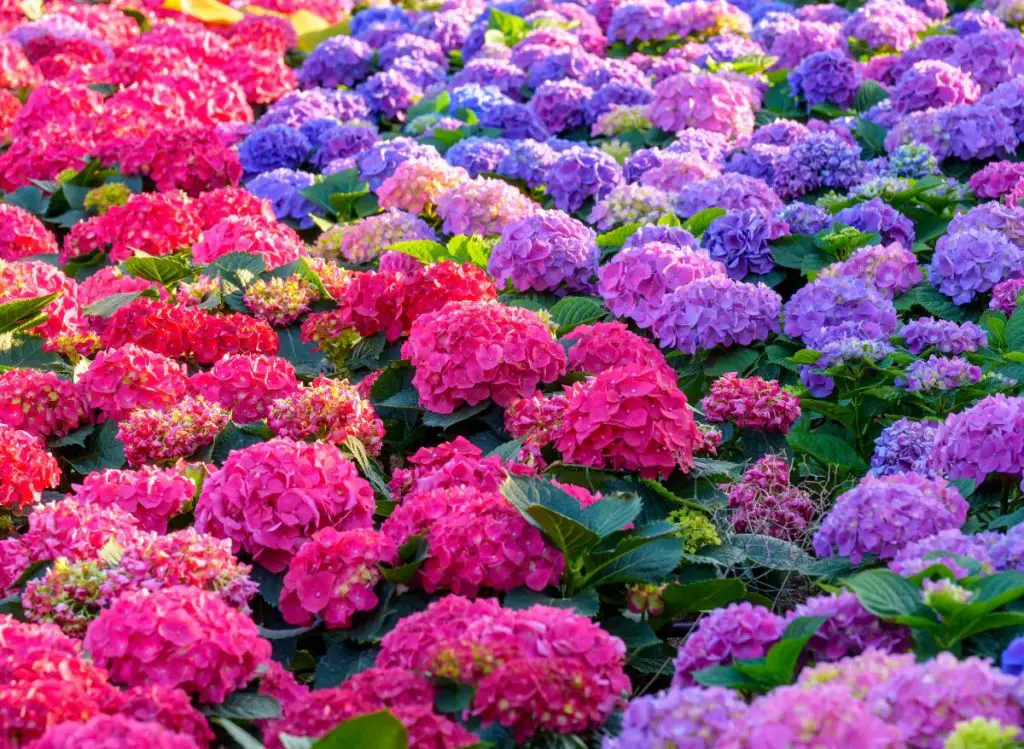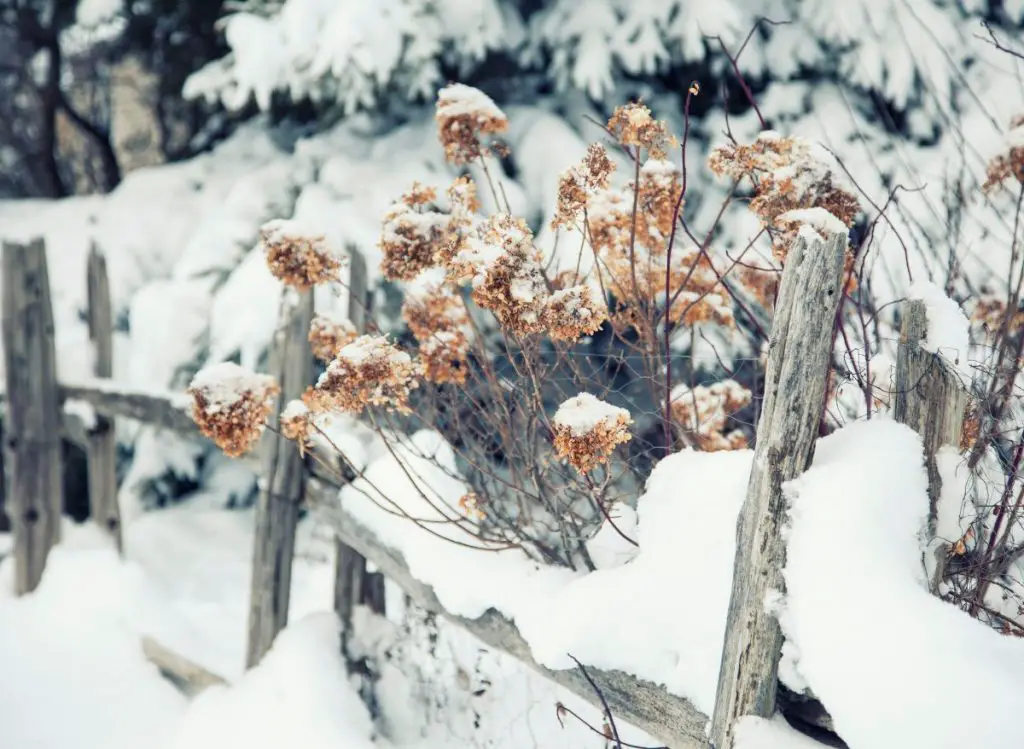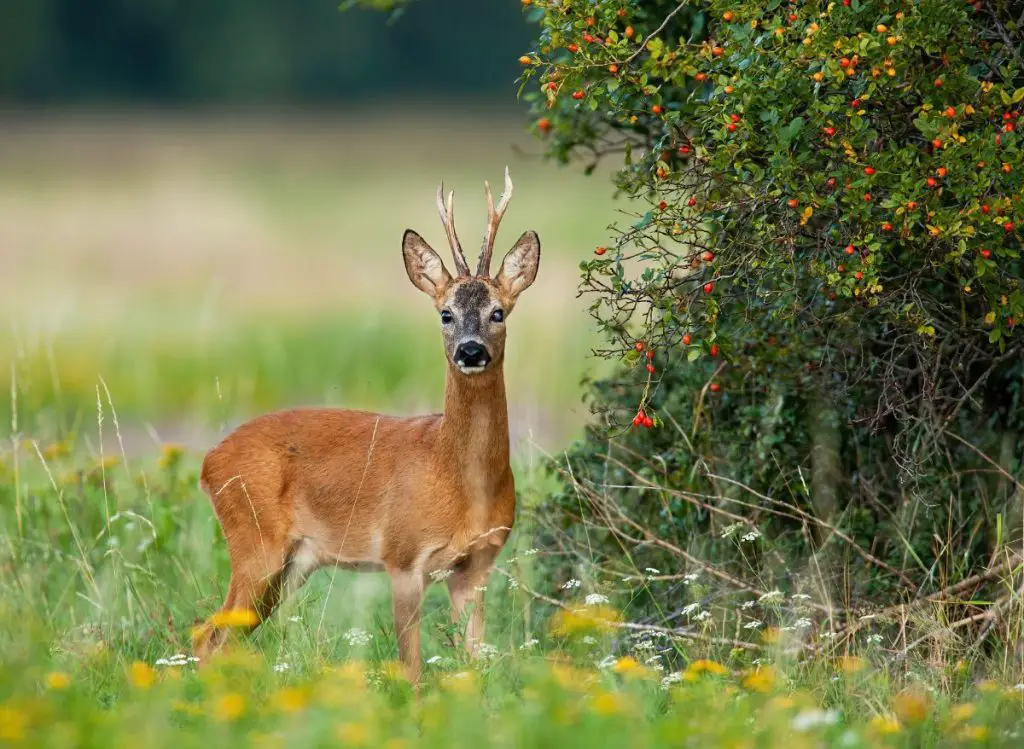This post contains affiliate links.

Hydrangeas are shrubs that are breathtaking when they are in full bloom and devastatingly disappointing when they won’t bloom.
Even though the shrubs have attractive foliage, hydrangeas are grown for their huge, long-lasting blooms, and without the blooms, they are just boring shrubs.
As the proud owner of a few hydrangeas that provide me with colorful blooms twice a year, I am often asked ‘why won’t my hydrangea bloom’ by friends and neighbors who see my shrubs.
Generally, the main reasons hydrangeas don’t bloom are late spring freeze, improper pruning, bud damage due to winter, and too much fertilizer. In addition, extreme heat, drought, or excessive sun exposure can affect how many flowers your Hydrangea produces. Pruning is one of the most critical factors.
If you have healthy hydrangeas shrubs that are not producing blooms, there are several reasons why your hydrangeas won’t bloom.
This article will detail some of those reasons and tell you how to fix them. Follow these tips, and you’ll never have to wonder why won’t my hydrangeas bloom again.
If you wonder whether Hydrangeas are perennials, I encourage you to read this article: Are All Hydrangeas Perennials? (Let’s find out!)
About Hydrangeas
Hydrangeas are native to Asia, Indonesia, Japan, and the Himalayan Mountains. There are over 75 species of this attractive plant, and they vary in size from a 1-foot-tall dwarf shrub to a 100 feet long vine.
Bloom colors are pink, blue, white, red, purple, and green, and the bloom color can be changed by changing the soil pH level in which the shrub is growing.
The large, beautiful blooms produced by this plant are what makes these so popular. Each bloom consists of a multitude of tiny flowers that fit tightly together to form a round or oval sphere of blooms. From a distance, it looks like one huge flower because all the tiny flowers are compacted together.
Hydrangeas put on a showy floral display from early spring until fall. The blooms are ideal for use as fresh-cut flowers or for creating a dried floral display. The shrubs can grow in partial shade to full sun; as the name indicates, they love water.
Since this is an ancient plant, it holds many different meanings and has been used for centuries as a symbol to convey messages.
- In the United States, hydrangeas are the recommended flower to give on the 4th wedding anniversary to symbolize appreciation and heartfelt emotion.
- During the Victorian era, white hydrangeas were used to convey the message that someone was being boastful and vain.
- A Japanese legend tells the story of an Emporer giving hydrangeas to the family of the young lady he had fallen in love with to show his intentions.
In our modern society, hydrangeas are grown and given because they are beautiful flowers; there’s no hidden message or symbolism.
You might also enjoy reading: Will Frost Hurt Your Mums? Here’s The Truth!
Reasons Why Your Hydrangea Isn’t Blooming And How To Fix Them
Hydrangea plants are among my favorite plants to grow. However, sometimes hydrangeas might not bloom as you expect them to.
And it might be disheartening and frustrating to find out that your hydrangea isn’t blooming.
If your hydrangea doesn’t flower, there are reasons and what to do to fix the issue. Here is why your hydrangea isn’t blooming and how to fix them.
1– Late Spring Freeze
The buds were set on the shrubs months ago and begin to swell in early spring. A late spring freeze in your area will kill all of the buds on the upper portion of the hydrangea.
Some of the lower buds may be saved because they are sheltered by the top part of the shrub, but the buds on top will not recover and bloom. The plant will not produce more buds that will flower in the same year.
How To Fix This Issue:
- To fix this problem, cover the shrub with a bed sheet, newspaper, or another lightweight item (not plastic) the night before a predicted late spring frost.
- Uncover the shrub first thing the following morning.
2- Not Enough Winter Protection
Hydrangeas are cold and hardy and thrive in growing zones 3-7. However, if the winter is particularly brutal, with consecutive days of frigid temperatures and snow cover, the shrub may not bloom the following year.
After a harsh winter, the hydrangea will focus its energy on repairing roots and tissues that were damaged during excessively cold temperatures.
The buds most likely froze, and your hydrangea won’t bloom.
How To Prevent This Issue:
- To prevent this from happening in the future, provide plenty of winter protection for the shrubs.
- Apply a 12-inch layer of organic mulch around the base of the shrub after the ground freezes in winter.
- Protect it from harsh winds by wrapping it with burlap.
- Drive 4 – 1×1 inch stakes in the ground that are as tall as the shrub.
- Wrap burlap around the shrub and staple it to the stakes.
- Brush snow off the shrub as soon as possible after a snowfall.

3- Improper Pruning
Before you prune your hydrangea, determine which variety you have. Some bloom on new growth, while others bloom on old growth.
How To Hydrangea Improper Pruning:
- New growth bloomers include smooth and panicle hydrangeas. These should be pruned in late winter or very early spring. Prune the branches back to just above a bud node.
- Old-growth bloomers include oakleaf, bigleaf, and climbing hydrangeas. When the shrub has finished blooming, these should only be pruned in late summer. The buds for next year’s blooms begin to form on the old growth as soon as the weather cools and the days become shorter.
- Bloom size is correlated to pruning. Aggressive pruning causes the new shoots to grow vigorously and produce blooms that are larger but fewer of them. Less aggressive pruning or just pruning a few tips off the shrub to tidy it up will result in smaller but more numerous blooms.
- Re-blooming varieties don’t need to be pruned except for removing dead or diseased branches.
4- Roots Disturbed
Hydrangeas have a shallow root system that only grows downward about 6 inches. The roots grow horizontally and will extend several inches past the anticipated mature size of the shrub.
This means that a 2-year-old established hydrangea may only be 2 feet tall and wide right now, but the roots may extend 4-6 feet out from the shrub in all directions in anticipation of the mature size of the shrub.
How To Fix This Issue:
- If there’s a lot of foot traffic on top of these extended roots or if you dig in the soil to plant other flowers and disturb the roots, the shrub could be stunted until the roots recover.
- The plant will put its energy into re-establishing its root system instead of producing blooms.
5- Plant At Right Time
Plant hydrangeas in the late fall before the ground freezes. This will give the shrub time to establish a root system before spring arrives.
The shrub may not bloom in the first season but will bloom in the second year. Hydrangeas can also be planted in early spring but don’t expect blooms the first year unless it’s an older shrub that has already set buds.
When Is The Right Time To Plant Hydrangeas?
- Plant after all danger of frost has passed in the spring and plant in the early morning to prevent the shrub from becoming heat stressed.
- Don’t plant hydrangeas during the summer. The soil and air temperatures are too warm, and the shrub will probably not survive.
6- Too Much Nitrogen
Nitrogen in the soil promotes an abundance of lush, green top growth. Which is a good thing unless it’s not being balanced out with phosphorus.
Test your soil with an inexpensive home soil testing kit that you can purchase at any garden supply center. The test will let you know what is in the soil and what may need to be added.
How To Fix This Issue:
- If the nitrogen level is too high or lacks enough phosphorus, apply bone meal around the base of the shrub to encourage buds and bloom development.
- Use a fertilizer with a lower first number (N for nitrogen) and higher second and third (P & K for potassium and phosphorus), like a 5-10-10.
See also: Are Mums Indoor Or Outdoor Plants? (With Examples Types Of Mums!)

7- Insufficient Light To Encourage Flowering
Generally, too much shade or sunlight impacts a hydrangea’s blooms. To bloom, hydrangea needs to receive an adequate amount of light.
Even though hydrangeas can flower well in the shade, most hydrangeas bloom more sumptuously in the dappled light under a tree canopy or partial sun, duplicating their natural growing conditions.
Consistent shade, without full sun or bright light, can cause slow growth of stems and foliage with few flowers.
Full sun can often scorch the hydrangea leaves (especially in hot climates). I suggest you find a good balance of shade and sunlight with either dappled light or exclusively morning sun to encourage your hydrangeas to flower.
How To Fix This Issue:
- Try transplanting your hydrangea to a sunnier spot.
- Cut back any overhanging tree limbs that appear overgrown and create too much shade over the hydrangea.
8- Moisture Can Prevent Hydrangeas Prevent Blooming
Hydrangeas do well in well-drained soil with constant moisture because the roots do not like saturated soil.
Remember that drought can also affect how well hydrangea bloom. In drought, I suggest you water your hydrangea as often as needed to keep the soil moist to a finger’s depth and use a mulch of compost and leaf mold and encourage hydrangea blooming.
How To Fix This Issue:
- Keep your soil well-drained.
- If you have sandy soil, I suggest adding some organic material to help the soil hold onto some water.
- Proper mulching is also essential to retain moisture at the plant’s ground and help prevent the water from evaporating.
9- Hungry Deer
According to the New Jersey Agricultural Experiment Station at Rutgers University, which works with experts to rate the deer tolerance of various plants, all groupings of hydrangeas, from bigleaf to climbing, are “occasionally severely damaged” by deer.
Plants “Occasionally Severely Damaged” are usually preferred by deer. It is recommended to plant hydrangea with additional protection like fencing or repellents.
Here is a list of hydrangea plants classified as “Occasionally Severely Damaged.”
- Hydrangea arborescens
- Hydrangea quercifolia
- Hydrangea paniculata
- Hydrangea macrophylla
- Hydrangea anomala petiolaris
The common concern is that the deer generally eat the buds on the old wood during winter, fall, or spring. Keep in mind that deers eat young green wood, buds, and leaves and avoid the stems of the leaves.
How To Prevent Deer From Eating Hydrangea:
- Add a fence works well in keeping deer from eating Hydrangea.
- You can also wrap plants in burlap, protecting Hydrangea plants from extreme cold, another culprit that may prevent them from blooming.
- You can also try applying a deer deterrent spray in the early evening. Deer are typically creatures of habit; by teaching them early to avoid your hydrangeas, they are more like to avoid them all season.
See also: 10 Garden Fence Security Ideas To Check Out!

Wrapping Up
Typically, hydrangeas will bloom during the first year of planting; however, certain varieties of hydrangeas need more time to establish.
I suggest being patient with hydrangeas as they might need more time to settle down before they begin flowering prolifically.
To make your plants bloom, ensure that you provide them with the appropriate amount of food and water they need to thrive.
Suppose you have established hydrangea plants that suddenly stop blooming. In that case, it is essential to investigate why your hydrangea isn’t blooming and follow the steps outlined in this article to fix them.

